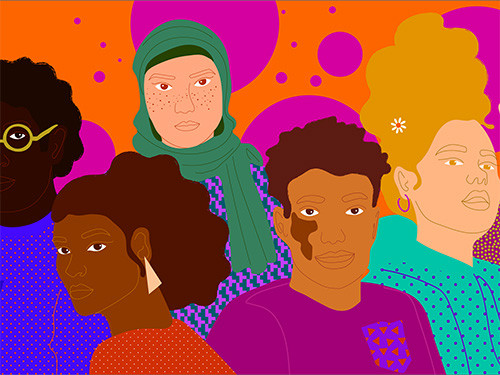 (Illustration by Aurélia Durand)
(Illustration by Aurélia Durand)
The practice of mentoring has evolved ever since formal research began on the practice in the 1980s. While most workplace activities, such as learning, development, working patterns, and project management, have become less formal, mentoring has gone the opposite direction: Initially, it was a relationship established by personal initiative—sometimes mutual—between two people of different experience and status levels. In recent decades, organizations have made mentorship contractual.
A 2010 Journal of Management paper defines mentoring as a delicate balance among “coaching, guidance, feedback, encouragement, and emotional support,” with the last element being the most important. A mentor, to note, is distinctly different from a sponsor: Unlike a sponsor, a mentor does not have a vested—particularly, a financial—interest in the success of the mentee. Mathematica Senior Fellow Catherine McLaughlin explains that “a mentor is seen as a role model, someone the [mentee] wants to emulate,” professionally or otherwise. The idea of being able to see yourself in someone else’s position further down the imagined career path is much easier for some people to imagine than those who do not see people like themselves in top-line management.

One of the business cases for mentoring has been to propel those who would otherwise struggle to reach the top ranks of management positions. This process is one that often transcends professional boundaries to create and deepen personal relationships. McLaughlin researched mentoring in academic spaces and found that there must be some affinity between the mentor and mentee for such relationships to flourish: “There needs to be some comfort level, some sense of familiarity, some shared and safe space for the mentoring relationship to be sustainable.” The mentoring training and consultancy firm Management Mentors agree, finding that it requires a safe environment in which the mentor and mentee are able to address some of “the obstacles, fears, prejudices, challenges [and] misconceptions” related to issues of diversity, equity, and inclusion.
Fostering Belonging
In the United Kingdom, 253,000 immigrants joined the workforce in 2018. Both new and seasoned workers are finding themselves in increasingly diverse, multicultural workplaces. Approximately 14 percent of the UK’s working population identify as an ethic minority, 98 percent of whom live in urban areas, according to the most recent census records. Statistically, this population comprises nearly 40 percent of the British workforce in urban areas such as London and Birmingham.
Despite becoming increasingly diverse, these workplaces have failed to cultivate a sense of belonging. The culture born from spaces dominated and managed by white men—coined “white bro culture”—permeates the business world. According to Farah Elahi, a trustee at the race equality think-tank The Runnymede Trust, this culture takes a “big mental health toll on individuals if they feel they’re not welcomed by the workplace.” In business, the psychological effects of this exclusion have consequences. Poor mental health has been connected to low productivity, higher staff turnover, and a reduced likelihood of employees being vocal supporters of, or ambassadors for, their organization.
This is the point at which mentoring must intervene—or rather preempt. Formalized mentoring programs in the workplace seek to create inclusion and belonging by ensuring that individuals feel welcome upon arrival and supported through a relationship that transcends the parameters of traditional professionalism. Mentorship that includes both development and pastoral care, or emotional support, significantly alters the diversity balance of company leadership. According to a 2016 Harvard Business Review study, organizations with mentoring programs that focused on specific identity groups produced overwhelmingly positive results: an 18 percent increase in leadership positions occupied by black women, a 23.7 percent increase in those occupied by Hispanic women, and a 24 percent increase in positions now held by Asian women.
Currently, however, there is a lack of appropriate representation in higher management levels at organizations that are able and willing to support younger employees through their professional and personal challenges. As the United Kingdom crawls towards the goal of The 2020 Campaign, which aims to have no all-white executive boards of FTSE100 companies by 2020, white people still dominate the vast majority of professions—including journalism, finance, law, and architecture. With the onus of responsibility often placed on mentees to “find” a mentor, the pool of eligible candidates in-house is much too narrow. This burden must be flipped for diversity mentoring to be successful.
Transforming Traditional Mentorship
A mentor traditionally occupies a position of power in the hierarchical structure of an organization relative to the mentee. But if mentoring is to establish more diversity, equity, and inclusion across sectors, we must reimagine the power dynamic of these two roles. Reverse mentoring achieves this reimagining through a model of mutual exchange. It is configured along the lines of age and position in the workplace hierarchy, whereby the younger, less experienced colleague offers the older professional lessons and skills relative to their age demographic. Not only are younger peers usually more familiar with the technology that organizations use in today’s fast-paced economy, but they are also more likely to be more informed about the latest social and cultural trends. Younger employees are also likely to be more racially and ethnically diverse and to have been brought up in a more diverse, global world than their older colleagues. The United Kingdom’s Foreign and Commonwealth Office (FCO) is pioneering a reverse mentoring scheme based entirely on ethnic minority employees coaching their white counterparts on unconscious bias and racial stereotypes. Reverse mentoring programs such as FCO’s allow for the discussion and subsequent education to be extended beyond demographic silos and spread into the wider workplace culture.
Reverse mentoring as diverse mentoring can break down traditional barriers that impede the advancement of racial minorities in the workplace. Upending the power dynamic of the traditional mentoring model promotes a sense of belonging and nurtures stronger connections between colleagues. It is this human connection that will lead to a more equitable future.
Support SSIR’s coverage of cross-sector solutions to global challenges.
Help us further the reach of innovative ideas. Donate today.
Read more stories by Sharlene Gandhi.

